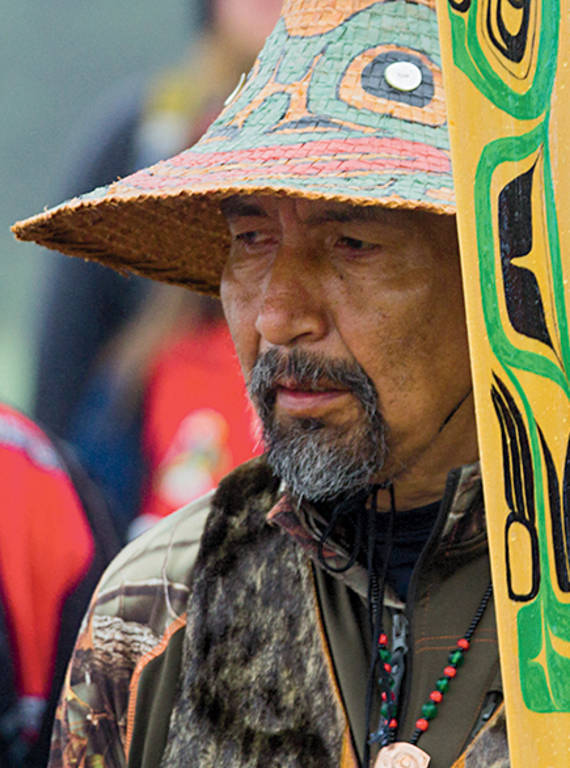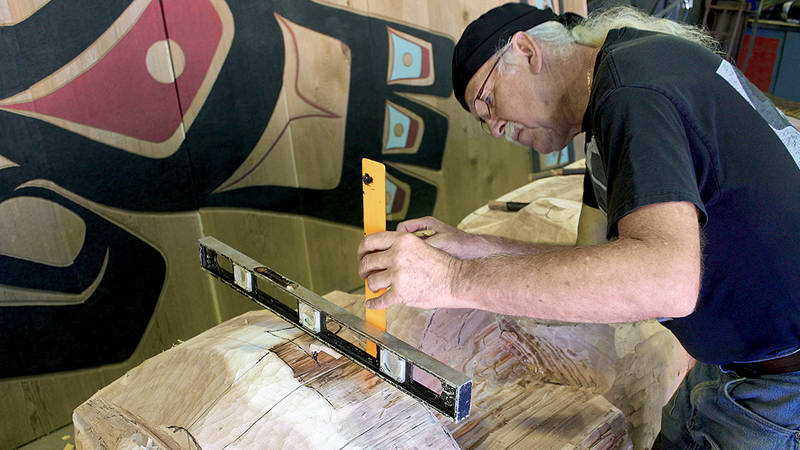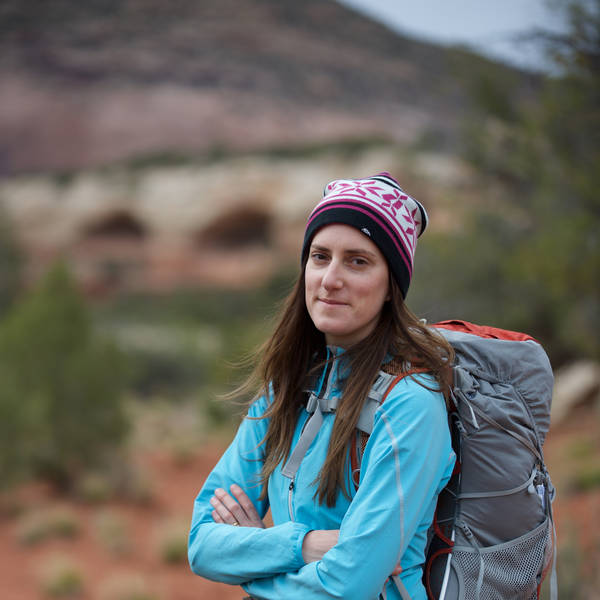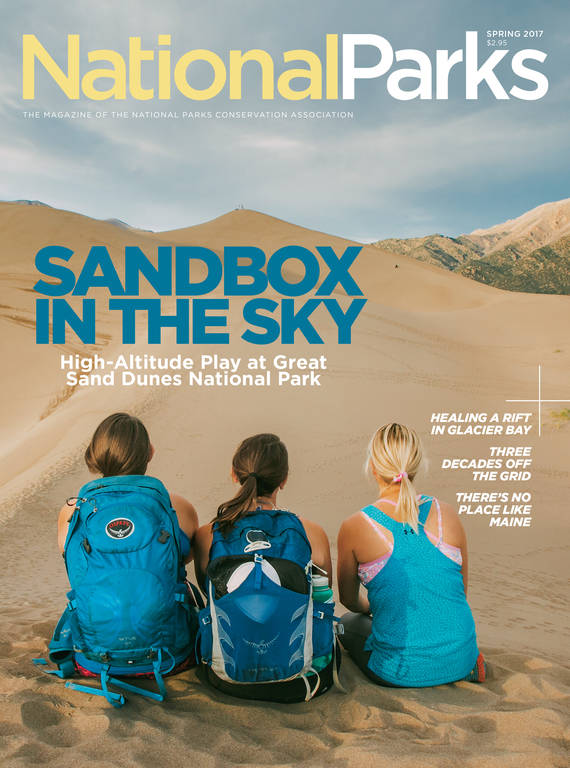Spring 2017
The Long Way Home
Opening a tribal house and closing a divide in Glacier Bay National Park and Preserve.
Barely a ripple disturbed the sea as three hand-carved red dugout canoes glided through a cove in Glacier Bay National Park and Preserve one serene morning in August. In each canoe, nine or 10 Huna Tlingit, in colorful vests and cedar-bark hats, plied the water with paddles they’d crafted themselves, singing.
On shore, some 800 tribal members, park staff and visitors waited. Dense fog blanketed the land and water, and they could hear the paddlers’ voices long before the canoes’ silhouettes came into view. It had been centuries since the Huna made the 30-mile journey by canoe from their current village, Hoonah, to their ancestral homeland in Glacier Bay National Park. They were ceremoniously returning to celebrate the dedication of a new Tribal House, the first to be built on these lands in hundreds of years.
That day, the canoes floated gracefully to shore amid chanting, drumming and singing. Clan elders burned cedar and spruce chips and poured seal oil over them to thank the trees that gave their lives for the construction of the house and canoes. During a naming ceremony, clan leaders called out Xunaa Shuká Hít, aa! as the crowd repeated it, a tradition believed to breathe life into the vaulted wooden structure. Later, in the long light of an Alaskan summer evening, some 300 people crammed into the 2,800-square-foot Tribal House, which smelled deeply of cedar. They danced and jumped and whooped, decked head to toe in colorful regalia.

At the grand opening, many of the Huna participants wore colorful vests and cedar-bark hats.
NPS“On that grand opening, this building was pounding, it was just throbbing with drumming and dancing,” said Tom VandenBerg, chief of interpretation for Glacier Bay National Park. “The atmosphere overwhelmed you. It was like, this building is now alive, it’s found its true place. Now it’s complete. I’ll never forget that.”
Officially opened in August, the Huna Tribal House now stands on the wooded shores of Bartlett Cove, the only developed area in the park, as a reminder to all who visit that this is Huna Tlingit homeland. More than 20 years in the making, it is a symbol of healing and a milestone in an effort to repair the long-troubled relationship between the tribe and the park.
Archaeologists have found Huna Tlingit artifacts in the Glacier Bay area from as early as 1250, and according to the tribe’s lore, their people have inhabited the region much longer than that. For early inhabitants, the bay was a land of abundance that provided good lives: Forests offered berries and an array of medicinal plants. Salmon clogged the rivers, and the ocean teemed with seals, fish and kelp.
In the mid-1700s, during what’s known as the Little Ice Age, the Grand Pacific Glacier steamrolled down the valley so fast it chased the Huna Tlingit 30 miles south to their present-day home, where about 450 tribal members still live. (An additional 650 live outside of Hoonah.) The glacier stretched all the way out to the ocean, reaching 100 miles long and 8 miles wide, before retreating mere decades later, leaving a radically different land. The salmon river was gone, and in its wake was an expansive, bare, rocky valley scoured of life and running with silty glacial meltwater. As the glacier shrank to its present size — 35 miles long and 2 miles wide — plants and animals started to return. And around the 1830s, the Huna did, too, setting up seasonal camps to fish, hunt, collect gull eggs and pick more than a dozen berry species that, to this day, still speckle the forest floor in shades of gray, red and blue.
Supporting Gull Egg Collection
Now, about half a million visitors see Glacier Bay every year, 95 percent of them from the decks of multistory cruise ships. I wanted to immerse myself in these forests and rocky coastlines, so I arrived from Juneau on a puddle-jumper and stayed at the only accommodation in the park, Glacier Bay Lodge, on Labor Day weekend, just before the visitor center closed for the long winter. Early one morning, I hopped aboard a 150-passenger catamaran that takes independent travelers on eight-hour trips up the enormous bay. From the deck of the Baranof Wind, I gazed over mist-clad ridgelines serrated with spruce trees that appeared dusty blue with distance. On South Marble Island, sea lions rocked and shoved one another off cliffs, roaring in the frigid September air. Sea otters popped their heads above water, and mountain goats negotiated bald cliffs. I even spotted a brown bear lumbering up a stream. Occasionally the thunder of calving glaciers filled the air, a monstrous sound I could feel in my gut.
Although the Grand Pacific Glacier obliterated most signs of habitation from the last two centuries, trained observers can still find rock cairns, old smokehouses, house posts, house pits and trees stripped of bark that could have been used for markers, baskets or shelter. But hidden on shore and in the forests, these remains go unnoticed by most visitors, and the land can feel empty.
One evening, I explored the woods in Bartlett Cove on foot. Sun reached the forest floor in bands of light that filtered through the thick canopy. I watched a raven swoop through trees blanketed in moss. At times, it was so still, I swear I could hear the flap of butterfly wings. Though I couldn’t discern any signs of civilization other than the trail I was on, something about the deep wet forests felt welcoming and human-scale.
GETTING THERE
The beauty of the area has touched many other travelers. Capt. George Vancouver, an English naval officer and explorer, noted the bay in 1794, when he sketched a map depicting an enormous glacier. John Muir made several visits between 1879 and 1899 and rhapsodized about it in his book, “Travels in Alaska.” And in 1916, Minnesota plant ecologist William S. Cooper visited and was so inspired by the wild seas and forests that he lobbied to have them protected. In 1925, Glacier Bay became a national monument. It was expanded in 1939 and again in 1980, when it became a national park and preserve.
When the monument was founded, the Huna Tlingit probably were unaware of this administrative decree from a far-off government. They were not consulted. Many tribal members didn’t speak English, and the National Park Service had little presence in the area other than an occasional visit from a ranger or two in Bartlett Cove. Tribal members largely continued to use the bay to hunt, fish, trap and collect traditional foods.
Over the decades, however, the Park Service became more involved and started to enact and enforce regulations that prohibited traditional activities. In the 1930s, the agency restricted firearm use to protect brown bears, and 10 years later, all hunting and trapping was outlawed. The Park Service continued to allow Huna Tlingit to hunt seals, but in 1976, the agency banned seal hunting entirely.
By the 1970s and ’80s, outsiders started to visit in greater numbers. As the Huna Tlingit watched cruise ships ferry passengers through their ancestral lands while they were barred from practicing their long-held traditions, deep resentment and anger grew. In October 1992, rangers cited a Huna man for shooting a seal that he intended to bring to a potlatch. They confiscated his rifle and the carcass and ordered him to appear before a federal magistrate in Juneau. Around the same time, the Park Service began conversations about phasing out commercial fishing, and the tribe’s fury bubbled over. That year, tribal members gathered in the park on the Bartlett Cove shore for a peaceful demonstration and ceremony, which ultimately led to discussions about ways to repair the frayed relationship.
“It was a long shot, but we wanted recognition,” recalled Ken Grant, then president of Hoonah Indian Association, the tribal government of the Huna Tlingit, and one of the organizers of the ceremony. “We wanted something tangible that would show that this was the Huna homeland.” In 1997, the Park Service officially adopted the idea of building a Tribal House in Glacier Bay. “It sounded hollow at the time,” said Grant, who later worked for the park as a boat captain and is now employed as a management assistant there. “But we just kept pushing — and pushing.”
The main obstacle was a perennial issue throughout the Park Service: funding. On the park’s long wish list of projects, the Tribal House never rose to the top. Wayne Howell, the cultural resources specialist at the time, continued to search for funding, but the project didn’t really take off until 2013. That’s when superintendent Susan Boudreau decided to allocate concessionaire franchise fees, which are normally used for things like scientific studies and special visitor programs, to the construction of the Tribal House. The $2.9 million project, a partnership between the Park Service and Hoonah Indian Association, aimed not only to create a home for the Huna in Glacier Bay and a resource for visitors, but to rekindle traditions and tribal knowledge that had eroded under the pressure of churches, schools and acculturation efforts.
In 2010, well before construction began, the tribe hired Gordon Greenwald, a tall, white-haired Huna carver, to begin work on the project. Carving is a traditional Huna Tlingit art, but the practice had been ebbing away when Greenwald, a former educator, became interested in teaching it to his students in the 1970s. Over the years, he studied with local elders as well as Huna and non-native carvers in other areas of Alaska, British Columbia and Washington.

Gordon Greenwald, a Huna carver, began working on the project in 2010.
NPSGreenwald agreed to work part-time over about five years to carve the totem poles, the interior posts and floor-to-ceiling wooden screens for inside and outside the Tribal House. He convinced carvers Owen James and Herb Sheakley Sr. and apprentice Louie White to join him, and together they transformed an old shop next to the school in Hoonah into a carving shed. It soon became a local hangout. Kids took classes from the carvers and simply dropped by after school to watch progress. A coffee pot often brewed, welcoming elders, who stopped in for a cup. Eventually their work space became a primary stop for cruise ship passengers visiting the tribal-owned Icy Strait Point port just outside Hoonah.

Inside Glacier Bay’s new Huna Tribal House.
© KATE SIBERFrom time to time, Greenwald and the other carvers sat with tribal elders and listened to stories of his people’s history, which he then transformed into sketches and eventually transposed onto the poles and screens using only hand tools and not even a scrap of sandpaper. Eventually the elders sat together and agreed upon a name for the house, which would help guide the carvers: Xunaa Shuká Hít. It roughly translates to Huna Ancestors’ House, but the meaning is more nuanced, suggesting the thread that connects past and future generations.
When I visited the carving shed on a rainy September morning, Greenwald and James had one large exterior totem pole done and two to go. Amid an array of tools, equipment and wood shavings, the mesmerizing, rhythmic sound of the adze on wood echoed throughout the two-story shop. Every Native carver has a unique style and, in a sense, is leaving a part of himself in the work, said James, adding that to carve well, you must clear your mind and be fully present. In their efforts, it seemed the carvers were aware of a sense of interconnection — among generations, Huna Tlingit and Park Service, and players seen and unseen.
“To think it could have been derailed so many times in so many ways — and the sacrifices that not only our own people made but sacrifices within the park system, it’s just hard to even fathom it,” said Greenwald. “To have the park do something like this, welcoming us back home, it’s huge.”
In April 2014, about 200 Huna Tlingit performed a groundbreaking ceremony, and the following year, construction began on the structure that would house the screens and posts. Aspects of the building are much different than they would have been centuries ago. Modern lighting beautifully illuminates the carvings, and the building is wired for the internet. The fire pit in the center of the floor runs on gas and can be controlled by a remote. In the past, each clan, essentially an extended family, would construct its own house; this Tribal House represents all four clans within the Huna Tlingit tribe, an idea that was controversial at first but has come to be accepted. The carved interior screen, which occupies one side of the space, depicts complex stories featuring the Grand Pacific Glacier, icebergs and all four clans, each in a separate canoe. A fifth canoe represents all other people; it is loaded with figures that hold their paddles vertically, in a sign of friendship. The house posts feature colorful human and animal figures from Huna Tlingit stories. In the spring, the carvers will deliver the last three exterior totem poles, representing the raven people and the eagle people — the moieties, or social groups, of the Huna Tlingit — and the turbulent relationship between the park and the tribe. That final story is intended as an emblem of healing.
“I don’t know of anything like it in the park system,” said Tom VandenBerg. “This is the direction the Park Service is going with diversity and connecting people with their history and their culture. It’s the perfect example of broadening the definition of ‘park.’” Park Service staff and tribal members hope that the project could act as a model for other parks that still have tense relations with local American Indians, who in some cases were chased out to make way for protected areas.
There are still plans to be worked out, such as how exactly the structure will be used by the tribe and what visitor programs will be offered. Some Huna grumble about the fact that the Tribal House is so far away, in Glacier Bay, which most Huna Tlingit visit only occasionally to fish or attend Park Service-sponsored events. Issues over resource management also continue to percolate, even though slow gains have been made. Hunting on parkland is still illegal, but in July 2014, President Barack Obama signed the Huna Tlingit Traditional Gull Egg Use Act. The bill, which NPCA strongly supported, will allow gull egg collection by Native people once harvesting regulations are in place.
“Both the Park Service and the Huna people have worked hard to mend relationships and move beyond past hurts,” said Mary Beth Moss, cultural anthropologist for Glacier Bay National Park, who is stationed in Hoonah and married to carver Owen James. “I don’t anticipate that the Tribal House will resolve all our differences, but it’s a bridge — a very important bridge.”

National Parks
You can read this and other stories about history, nature, culture, art, conservation, travel, science and more in National Parks magazine. Your tax-deductible membership donation of $25 or more entitles…
See more ›Even with its detailed carvings, the Tribal House itself couldn’t possibly tell all of the stories of the Huna Tlingit — the winter nights with feasts of smoked fish, seal meat and berries preserved in seal oil; the loss and devastation as European disease ripped through their communities — nor does it preserve the poetic nuances of their beautiful, endangered language. But inside the house on a rainy, mist-shrouded day, I could sense the connection between land and people. I imagined what it must have been like here during the opening celebrations, with all the bodies jumping and chanting in their finery. Even in the dim light and solitude of a fall afternoon, it really did feel as if the Huna had breathed life into this building, named after ancestors who had walked this very shore and gazed over the wading herons, the tide pulled out to sea and the mountains veiled in fog. Every tribal member I spoke with expressed how healing and validating it felt to be part of the celebration and how unique it was to be there together.
“It was real good to be able to have some acknowledgment from the Park Service,” said Fred Fulmer, a carver from Juneau who participated in the opening ceremonies. Fulmer’s mother grew up visiting Glacier Bay to gather berries and gull eggs. “It was great to be there, to be able to bring out the regalia that belong to our ancestors. I got to wear an old blanket and a bear hat made out of cedar. It was my great-grandfather who made that. It was awesome. It was an honor.”
About the author
-
 Kate Siber Contributor
Kate Siber ContributorKate Siber, a freelance writer and correspondent for Outside magazine, is based in Durango, Colorado. Her writing has appeared in National Geographic Traveler and The New York Times. She is also the author of “National Parks of the U.S.A.,” a best-selling children’s book.



